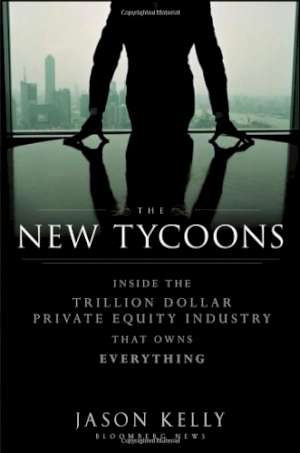01 May 2013
The New Tycoons
Inside the Trillion Dollar Private Equity Industry that Owns Everything
Jason Kelly
2012, Bloomberg Press, 232 pages, £23.99
ISBN 1118205464
Reviewer: Nooman Haque

Companies owned by private equity (PE) firms employ 8.1m people in the US out of a workforce of 154m; the industry manages $2 trillion of assets, mainly on behalf of long-term investors like pension funds and endowments. And in the debt-fuelled binge of 2005-7, the industry registered some extraordinary statistics: $500bn raised for PE funds and nine of the ten largest PE deals ever completed (including the biggest, the $43bn buyout of energy company TXU). And if that wasn’t enough, while Goldman Sachs CEO Lloyd Blankfein was derided for earning $54m in 2007, Steve Schwarzman of Blackstone quietly took home nearly $400m.
PE, despite the existence of venture capital and growth funds, has come to be defined by the leveraged buyout. In this book Kelly provides potted biographies of the key firms and their founders, and the issues arising from their style of investing - essentially mortgaging businesses to arbitrage between debt and equity markets. The ‘private’ nature of the industry contributes to outsize returns - think information advantage - but with Bain founder Mitt Romney’s presidential candidacy and the focus on his job creation record within PE, the industry is under the spotlight.
The strategies of the largest firms strengthen the view that the industry is changing. Cheap and plentiful debt - the driver of returns - is not as widely available; the record volume of funds raised is chasing fewer deals and eroding the information advantage; the Initial Public Offering (IPO) of notable firms has created a wedge between the permanent fund capital from long-term investors and the IPO investors, and the largest firms have long been diversifying into other strategies such as credit, or in the case of Blackstone, becoming institutional financial behemoths in which PE plays a relatively small part.
Kelly takes us on a logical tour of the industry, beginning with the investors, and traces its evolution from the 1970s and 1980s when financial engineering dominated, through to the emergence of ‘ops’ units specialising in building up and turning companies around. We get inside some of the portfolio companies and the disputes arising between the new owners and workers. Frustratingly, Kelly raises key issues but does not explore them in detail. For example he covers some of the academic research on job creation (ambiguous), investment performance (it depends on the year, but is generally declining) and political hot potatoes like the tax treatment of carried interest. It is disappointing that this issue in particular, given the economic policy debate, is not explored further. Similarly, the Volcker rule is mentioned in passing, despite the obvious point that if it makes sense to limit a bank’s exposure to private equity, then surely a private equity firm like Blackstone, that is becoming more and more like a bank, should be limited from its own original PE activities.
However, The New Tycoons raises an important question that practitioners must face up to. PE has occupied a niche that complements but is not correlated to public markets. But in an investment climate dominated today by volatile public markets and a seeming disconnect between ‘fundamentals’ and prices, where should PE focus? There is a suggestion that the new niche is in offering lower but stable returns. Not all in the industry agree, and the common view amongst the pure play PE firms is that outsized returns will and should always be the focus. But how does that gel with the pension liabilities of larger investors in an ageing population. Surely a vocal retirement lobby will pressure an industry to deliver stability?
Despite these technical issues, people seem more interested in whether PE is a good or bad thing. At one level, the question seems ridiculous - as one of Kelly’s interviewees puts it, “Private equity just is”. Capital is fungible so why should PE be questioned as distinct from other capital. But the fact the question appears to make sense on an emotional level illustrates how important the motivations of PE and its institutional baggage (tax treatment of carried interest etc) are. And in fact PE is a nexus for the role of all capital markets today. Perhaps capital should ideally be amoral as Kelly’s respondent seems to imply but is that realistic? As these firms, and their brethren in the banking industry struggle with their being the focus of attention and public disapproval, perhaps the answer lies in imbuing them with a positive morality rather than a casual disinterest.
